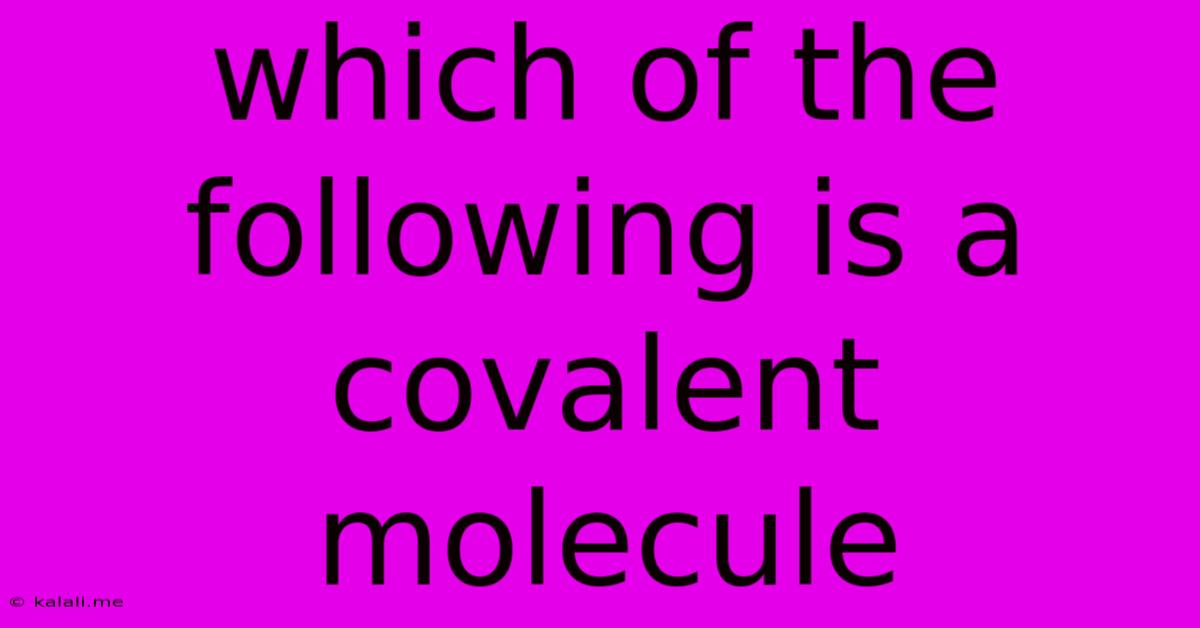Which Of The Following Is A Covalent Molecule
Kalali
Jun 14, 2025 · 3 min read

Table of Contents
Which of the Following is a Covalent Molecule? Understanding Chemical Bonds
This article will explore the concept of covalent molecules and help you identify them from a list of chemical compounds. Understanding the nature of chemical bonds is crucial in chemistry, and distinguishing between covalent and ionic bonds is a fundamental step. This guide will provide you with the knowledge to confidently determine which molecule exhibits covalent bonding.
Covalent bonding occurs when two or more non-metal atoms share electrons to achieve a stable electron configuration. Unlike ionic bonds, which involve the transfer of electrons, covalent bonds share electrons, creating a strong bond between the atoms. This sharing leads to the formation of molecules. The strength of these bonds varies depending on the atoms involved and the number of shared electron pairs.
Identifying Covalent Molecules:
To identify a covalent molecule, you need to look at the elements involved. Generally, covalent molecules are formed between non-metal atoms. Here's a breakdown:
-
Non-metals: These are elements found on the right side of the periodic table (excluding hydrogen which sometimes acts as a non-metal). Common examples include hydrogen (H), carbon (C), nitrogen (N), oxygen (O), phosphorus (P), sulfur (S), chlorine (Cl), bromine (Br), iodine (I), and fluorine (F).
-
Metals: These are elements found on the left side of the periodic table. They tend to lose electrons to form positive ions.
A molecule formed solely from non-metals is almost certainly a covalent molecule. Let's look at some examples:
Examples of Covalent Molecules:
-
Water (H₂O): Water is a classic example of a covalent molecule. Hydrogen and oxygen are both non-metals, sharing electrons to form the water molecule.
-
Carbon Dioxide (CO₂): Carbon and oxygen are non-metals, forming covalent bonds to create carbon dioxide.
-
Methane (CH₄): Methane, the primary component of natural gas, is another great example. Carbon and hydrogen, both non-metals, share electrons covalently.
-
Ammonia (NH₃): Nitrogen and hydrogen share electrons to form the ammonia molecule.
-
Hydrogen Chloride (HCl): Hydrogen and chlorine form a covalent bond in hydrogen chloride gas.
Distinguishing Covalent from Ionic Molecules:
It's essential to distinguish covalent bonding from ionic bonding. Ionic bonds form when a metal atom donates an electron to a non-metal atom, resulting in the formation of ions (cations and anions) held together by electrostatic forces. For example, Sodium Chloride (NaCl) – table salt – is an ionic compound, not covalent. Sodium is a metal, and Chlorine is a non-metal.
Which of the following is a covalent molecule? (Example)
Let's say you are given a multiple-choice question:
A. NaCl B. H₂O C. MgO D. KCl
The correct answer is B. H₂O. Both hydrogen and oxygen are non-metals, indicating a covalent bond. NaCl, MgO, and KCl all involve a metal and a non-metal, signifying ionic bonds.
By understanding the fundamental principles of covalent bonding and the properties of metals and non-metals, you can confidently identify covalent molecules. Remember to examine the constituent elements of the compound to determine the type of bond present.
Latest Posts
Latest Posts
-
Which Of The Following Devices Measures Air Pressure
Jun 15, 2025
-
What Is The Difference Between Glycogen And Starch
Jun 15, 2025
-
T20 World Cup 2030 Host Country
Jun 15, 2025
-
Copper And Zinc Alloy Is Known As
Jun 15, 2025
-
Sample Of Letter To Close Bank Account
Jun 15, 2025
Related Post
Thank you for visiting our website which covers about Which Of The Following Is A Covalent Molecule . We hope the information provided has been useful to you. Feel free to contact us if you have any questions or need further assistance. See you next time and don't miss to bookmark.